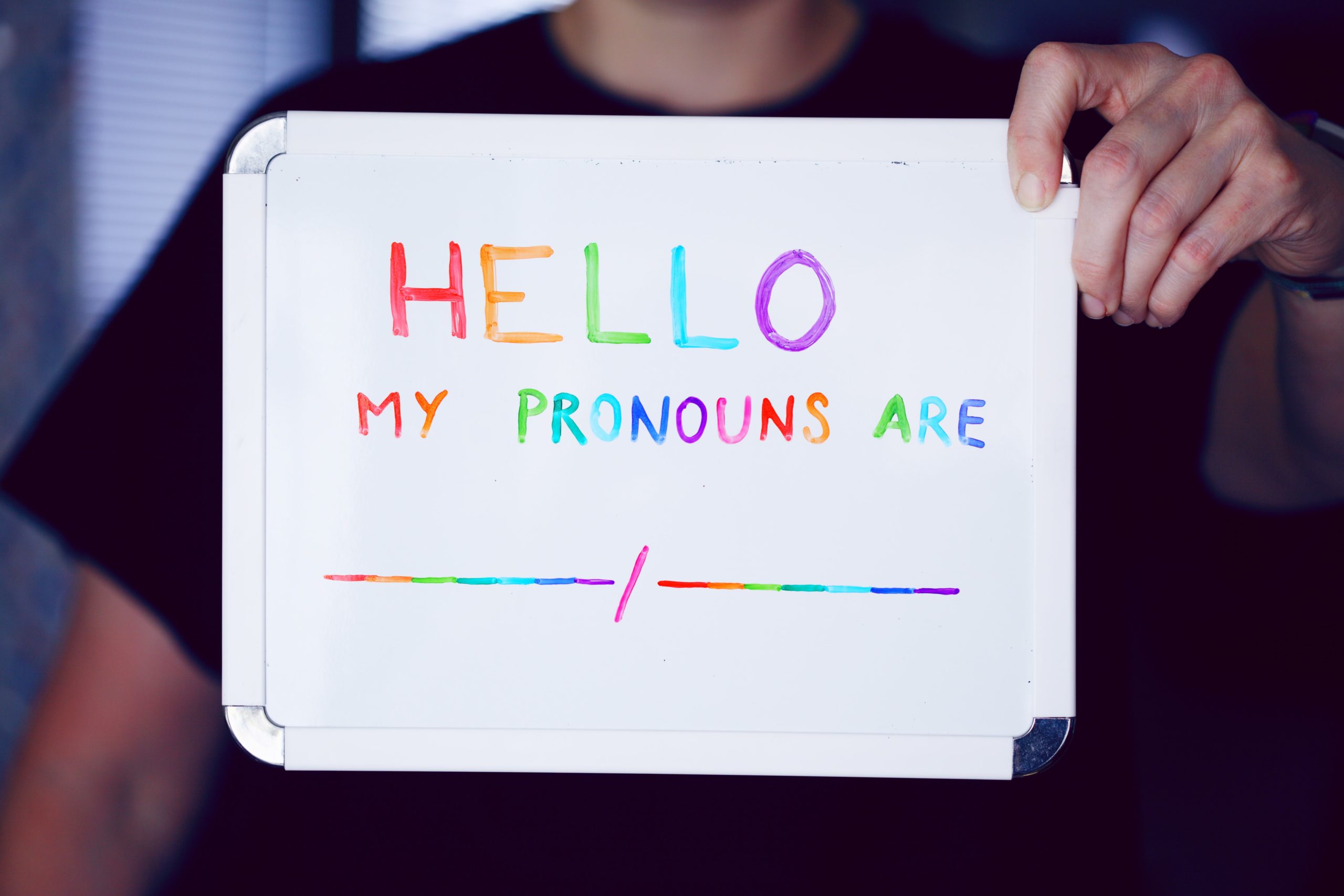Written by Lexi Schlosser, Faculty Developer of Online Learning and Becca Ciancanelli, Director of Inclusive Teaching Practices
Pronouns are typically used to refer to a person when not using their name and are often associated with gender. It is important to not make assumptions about the gender of another person and to use their correct pronouns. Using the correct gender is an affirming and respectful practice (Shea, 2021). Social affirmation, which includes calling a student by their chosen name and personal pronouns, increases a sense of belonging in the classroom (Norris & Welch, 2020). Throughout this blog, we will highlight the purpose of pronoun sharing paired with strategies to use in your teaching practice.
“It is a privilege to not have to worry about which pronoun someone is going to use for you based on how they perceive your gender. If you have this privilege, yet fail to respect someone else’s gender identity, it is not only disrespectful and hurtful, but also oppressive” (p.1).
– University of Wisconsin, Milwaukee, LGBTQ+ Resource Center
Classroom Strategies
- Share your pronouns when you introduce yourself to normalize the practice
- Offer a statement on the syllabus regarding use of pronouns in the classroom
- Encourage students to include their personal pronouns on their Canvas profile
- Include pronoun etiquette when developing establish ground rules for your classroom
- Allow students to report instances of misgendering
- Share the class pronoun etiquette with any guest speaker and invite them to participate
- Ask students for feedback/resources to deconstruct gender binaries in course content and activities
- Include your pronouns on your email signature, business cards, and name tags, if comfortable.
“1 in 4 LGBTQ+ youth use pronouns outside of the gender binary.”
How to Navigate Misgendering
Misgendering is addressing people with incorrect gender pronouns, after they have clearly identified the pronouns that they use. Even if misgendering is unintentional, it causes stress for the person who has been misgendered (Nordmarken, 2014, Spade, 2011).
- Try to avoid misgendering by making sure to learn your students’ pronouns at the beginning of each term.
- If you witness misgendering, speak up so that the person who is misgendered doesn’t have to.
- If you misgender a student, apologize. You can correct mid-sentence.
- If you are corrected, thank the person who corrected you and is holding you accountable for this important communal practice
- Hold yourself accountable to not repeat mistakes. If you are consistently misgendering someone, do the work to correct your mistakes.
Gender Inclusive Language
There are several common phrases that people use naturally, and have used over time, that reference particular genders. We often use these terms without realizing the harm their language may cause to folks who do not identify with the assumed gender. Try to pay attention to your language and find ways to incorporate gender-neutral terms, like ours listed below.
- Instead of “hey guys” or “you guys,” say “hey all” or “you all.”
- Instead of speaking or writing, “he or she” when referencing an unknown or universal person, consider using “they,” or “the person/student/teacher.”
- Instead of “boys and girls” or “ladies and gentlemen,” say “everyone” or “colleagues.”
Sharing pronouns as a teaching practice must involve a strong personal connection to values of inclusivity. Identify your DU community partners to process misgendering, deadnaming (calling a trans person by their birth name after they have adopted a new name), and other mistakes that might cause mistrust and disconnection from your students (Sinclair-Palm, 2017). Keep reading and reflecting on the experiences of nonbinary and gender fluid students and continually challenge yourself to deconstruct gender binary structures in your language.
For additional support:
- Attend (or request) a Queer & Ally training or workshop through Student Affairs and Inclusive Excellence
- Schedule individual consultations for help with Canvas pronoun options or request a department consultation to discuss inclusive teaching practices with the OTL
- Learn more about gender and sexuality in the Sexual Orientation and Gender Identity module on the Inclusive Teaching Practices webpage
- Come by the OTL for a copy of: Nicolazzo, Z. (2017). Trans* in College: Transgender Students’ Strategies for Navigating Campus life and the Institutional Politics of Inclusion
- Consider checking out Beemyn, G. (2019). Trans People in Higher Education. State University of New York Press (an eBook from the DU library).
References
Nordmarken, S. (2014). “Microaggressions”. Transgender Quarterly. 1: 129-134. https://doi.org/10.1215/23289252-2399812
Norris, M. & Welch, A. (2020). “Gender pronoun use in the university classroom: A post-humanist perspective”. Transformation in Higher Education. 5. DOI:10.4102/the.v5i0.79
Shea, H. (Host). (2021, December 1). Beyond Pronouns (No. 73) [Audio podcast episode]. In Student Affairs NOW. https://studentaffairsnow.com/pronouns/
Sinclair-Palm, J. (2017). “It’s Non-Existent”: Haunting in Trans Youth Narratives about Naming. Occasional Paper Series, 2017 (37). Retrieved from https://educate.bankstreet.edu/occasional-paper-series/vol2017/iss37/7
Spade, D. (2011). “Some Very Basic Tips for Making Higher Education More Accessible to Trans Students and Rethinking How We Talk about Gendered Bodies”. Radical Teaching. 92: 57-62.
The Trevor Project. (2020). National Survey on LGBTQ Mental Health. New York, New York: The Trevor Project. Retrieved from https://www.thetrevorproject.org/research-briefs/pronouns-usage-among-lgbtq-youth/
University of Wisconsin, Milwaukee, LGBTQ+ Resource Center (n.d.) Why is it important to respect people’s pronouns? University of Wisconsin Milwaukee. Retrieved from https://uwm.edu/lgbtrc/qa_faqs/why-is-it-important-to-respect-peoples-pronouns/.



